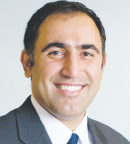The use of maintenance therapy in older patients with acute myeloid leukemia (AML) is theoretically sensible, but its clinical value remains uncertain. The phase III HOVON97 randomized study demonstrated that maintenance therapy with the hypomethylating agent azacitidine may improve disease-free survival and possibly overall survival in older patients in complete remission following intensive chemotherapy.1
“Maintenance therapy with azacitidine was well tolerated and significantly improved disease-free survival compared with no maintenance. Adherence to the protocol was good, and transfusions were rarely necessary,” said lead author Geert Huls, MD, PhD, of University Medical Center Groningen, the Netherlands, at the 2017 American Society of Hematology (ASH) Annual Meeting & Exposition.

Maintenance therapy with azacitidine was well tolerated and significantly improved disease-free survival compared with no maintenance.— Geert Huls, MD, PhD
Tweet this quote
“After obtaining a complete response with incomplete platelet recovery, an AML patient may have a myelodysplastic syndrome–like state. The applicability of allogeneic transplant is limited in clinical practice, and applying an ‘effective, new’ treatment modality like a hypomethylating agent is attractive,” Dr. Huls told listeners, explaining the rationale for the study.
The study was designed to include 128 patients aged 60 and older who had a confirmed diagnosis of AML, or a diagnosis of refractory anemia with an excess of blasts, and who were in complete remission or complete remission with incomplete platelet recovery following 2 cycles of chemotherapy. The trial was stopped early because of slow accrual.
The study population included 116 patients randomized to no maintenance (n = 60) or maintenance with azacitidine (n = 56). Patients were treated until relapse for a maximum of 12 cycles. The primary endpoint was disease-free survival, measured from time of randomization to relapse or death from any cause. Secondary endpoints included survival, probability of relapse and death, and number and duration of hospitalizations.
Study Results
The treatment arms were well balanced for demographic and disease characteristics. Median age was 69 years. Poor-risk cytogenetics were identified in 16% to 23% of patients.
Twenty-three patients (38%) in arm A (observation) and 35 patients (63%) in arm B (azacitidine) completed the protocol. The remaining patients all relapsed prior to completion of the protocol.
A total of 14 adverse events were reported in the azacitidine maintenance arm vs 4 in the observation arm. There was one serious adverse event in the azacitidine arm. The percentage of patients who did not receive platelet transfusions during the study was 93% for observation vs 86% for azacitidine; the percentage of patients without red blood cell transfusions was 92% and 86%, respectively.
Maintenance therapy was superior to observation for disease-free survival in the overall study (P = .03). After adjusting for poor-risk cytogenetics at diagnosis and platelet count at randomization, the difference in disease-free survival remained significant (P = .019).
MAINTENANCE THERAPY IN AML
- HOVON97 randomized 116 AML patients (median age = 69 years) in complete remission or complete remission with incomplete platelet recovery to no maintenance or maintenance with azacitidine.
- Patients were treated until relapse for a maximum of 12 cycles.
- Maintenance therapy was superior to observation for disease-free survival, the primary endpoint (P = .03).
- The trial was stopped early because of slow accrual and is therefore not definitive.
Overall survival was not significantly different between the two arms. The investigators noted that more patients in the observation arm required salvage treatment (32 vs 9). More allogeneic transplants were performed in the observation arm as well (11 vs 3).
“The difference in allogeneic transplant between the two arms was remarkable,” Dr. Huls said. He suggested that the excess of transplant procedures in the observation arm may have been related to “the psychology of the doctors.”
“In the maintenance arm, the physician may have thought this patient had two lines of treatment and relapsed and ‘we are done.’ But in the observation arm, he may have said, ‘Well, the patient has had one arm of treatment. Let’s go for another,’” he speculated.
In a survival analysis censored for transplant, overall survival favored maintenance over observation, approaching statistical significance (P = .07). A planned subgroup analysis according to risk status showed that good-, intermediate-, and poor-risk groups all had a benefit in disease-free survival from maintenance azacitidine. ■
DISCLOSURE: Dr. Huls has served on the advisory boards of Janssen and Celgene.
REFERENCE
1. Huls G, Chitu DA, Havelange V, et al: Randomized maintenance therapy with azacitidine (Vidaza) in older patients (≥ 60 years old) with acute myeloid leukemia and refractory anemia with excess of blasts: Results of the HOVON97 phase III randomized multicenter study (Eudra-CT 2008-001290-15). 2017 ASH Annual Meeting. Abstract 463. Presented December 10, 2017.


